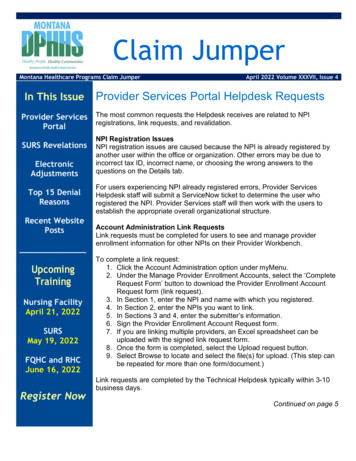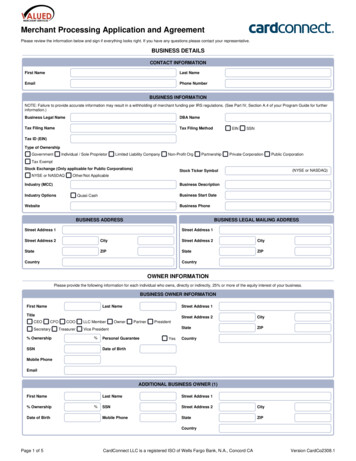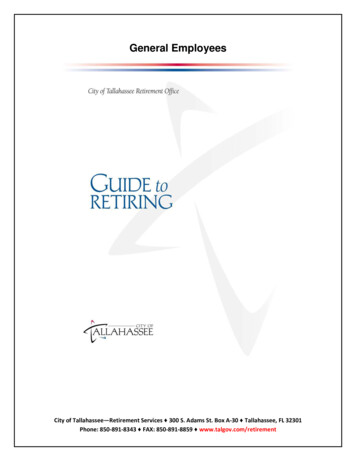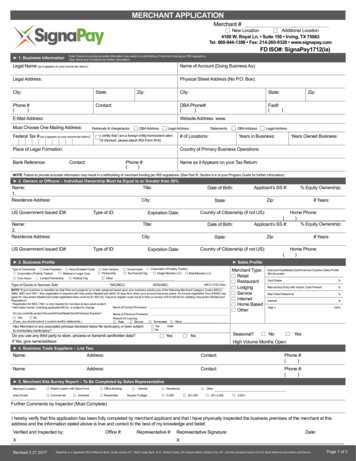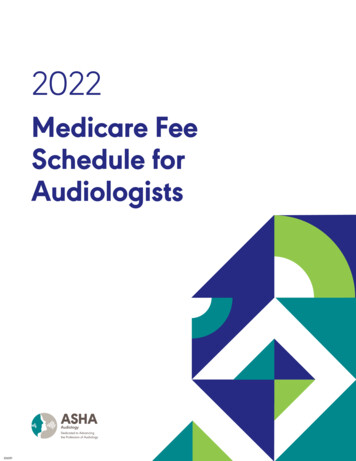
Transcription
2022Medicare FeeSchedule forAudiologists226051AudiologyDedicated to Advancingthe Profession of Audiology226051
General InformationThe American Speech-Language-Hearing Association (ASHA) developed this document to provide ananalysis of the 2022 Medicare Physician Fee Schedule (MPFS), including comments on relevant policychanges, a list of Current Procedural Terminology (CPT American Medical Association) codes usedby audiologists with their national average payment amounts, and useful links to additional information.Audiologists should always consult their local Medicare Administrative Contractor for final rates andcoverage guidelines.ASHA’s Medicare outpatient payment website provides additional information regarding the MPFS,including background information, how providers should calculate Medicare payment, and audiologyspecific payment and coding rules. If you have any questions, contact reimbursement@asha.org.Updates and RevisionsDecember 27, 2021 Added information on Congressional action to mitigate the Medicare payment cuts. (p. 3-4) Updated the 2022 conversion factor. (p. 3) Updated national payment rates and relative value units in Tables 1-3. (p. 8)Second EditionDecember 27, 2021
Table of ContentsOverview. 3Analysis of the 2022 Medicare Physician Fee Schedule (MPFS) . 3Payment Rates . 3Conversion Factor (CF) . 3Payment Changes for Audiology Services . 4Relative Value Units . 4CPT and HCPCS Code Updates . 5Deleted Codes . 5New Remote Therapeutic Monitoring (RTM) Codes . 5Extended Virtual Check-In Code . 5Medicare Telehealth Services . 5The Quality Payment Program (QPP) . 6Merit-Based Incentive Payment System (MIPS). 6Advanced Alternative Payment Models (APMs) . 72022 Medicare Physician Fee Schedule for Audiology Services . 8Table 1. National Medicare Part B Rates for Audiology Services . 8Table 2. National Medicare Part B Rates for Treatment, Electrophysiology, or Non-BenefitServices . 16Table 3. Detailed Relative Value Units (RVUs) for Audiology Services . 21How to Read the MPFS and RVU Tables . 23References . 24
OverviewOutpatient audiology services provided under Part B of the Medicare program are paid under theMedicare Physician Fee Schedule (MPFS). Congress approves annual payment updates to the MPFS,which are frozen at 0.0% from 2020 through 2025 because of a provision in the Medicare Access andCHIP Reauthorization Act of 2015. Additional payment adjustments—based on legislative actions, orparticipation in the Merit-Based Incentive Payment System (MIPS) or Advanced Alternative PaymentModels (APMs)—may also apply.Rates associated with individual Current Procedural Terminology (CPT ) codes may continue tofluctuate due to adjustments to professional work, practice expense, and malpractice insurance valuesthat are part of the fee calculation. In addition, the Centers for Medicare & Medicaid Services (CMS) mayrequest review and revaluation of certain codes that are flagged as potentially misvalued services.This document includes regulations and rates for implementation on January 1, 2022, for audiologistsproviding services to Medicare Part B beneficiaries under the MPFS. Key policies addressed in thisanalysis include new codes for remote therapeutic monitoring; audio-only virtual check-in services;telehealth services; quality reporting; APMs; and national payment rates for audiology-related services.ASHA’s Medicare outpatient payment resources provide additional information regarding the MPFS,including background information, instructions for calculating Medicare payment, and audiology paymentand coding rules. Note that a separate payment system applies to audiology services provided in hospitaloutpatient departments. If you have any questions, please contact reimbursement@asha.org.Analysis of the 2022 Medicare Physician Fee Schedule (MPFS)ASHA reviewed relevant sections of the 2022 MPFS final rule and offers the following analysis of keyissues for audiologists.Payment Rates(updated 12/27/21)CMS did not finalize specific actions to mitigate the payment cuts set to return in 2022 for audiologists,speech-language pathologists (SLPs), and over 30 other Medicare provider groups. These cuts wouldhave gone into effect in 2021 due to changes in payment for outpatient office-based evaluation andmanagement (E/M) services and adjustments to the annual conversion factor. Although advocacy byASHA and other stakeholders prevented some of the payment cuts and mitigated other payment cuts forthe duration of 2021, the cuts were set to return in full in 2022.However, continued advocacy resulted in provisions of the Protecting Medicare and Farmers fromSequester Cuts Act (P.L. 117-71) that significantly reduced 2022 payment cuts by approximately 8%. Asa result, ASHA estimates audiologists will now see an overall 2% decrease in 2022 payments.ASHA remains fully committed to fighting any cuts to Medicare reimbursement. While far from ideal, S.610 reduces near-term Medicare payment cuts—which could have been as high as 10% or more—allowing additional time for ASHA to continue working toward a long-term policy solution.Learn more about ASHA’s ongoing efforts to stop the Medicare payment cuts and join the fight toconvince Congress to more fully address these cuts by urging support for the Supporting MedicareProviders Act of 2021(H.R. 6020/S. 3314).Conversion Factor (CF)CMS uses the CF to calculate MPFS payment rates. CMS initially established a calendar year (CY) 2022CF of 33.59, representing an almost 4% decrease from the 34.89 CF for 2021, and an almost 7%All CPT codes and descriptors are copyright 2021 American Medical Association3
decrease from the 2020 CF, due in large part to the E/M code changes and the expiration of the 3.75%payment adjustment. Following Congressional intervention, the updated CY 2022 CF is now 34.61,representing a 3% increase from the initial CF.Payment Changes for Audiology ServicesAs a result of provisions of P.L. 117-71, audiologists will see the following adjustments on 2022payments. A cut of 0.75% to the Medicare Part B conversion factor, which applies to every service beforeco-insurance, deductibles, and other payment adjustments applied at the claim level throughout2022 (reduced from a 3.75% cut). Table 1 (p. 8) reflects payment rates with the 0.75% reduction. A separate, phased-in cut—known as sequestration—applies to all claims after co-insurance,deductibles, and other payment adjustments: Audiologists will experience no sequestrationreductions in the first quarter of 2022, a 1% cut in the second quarter, and a 2% cut in the thirdand fourth quarters for a cumulative 1.25% cut over the year (reduced from a cumulative 6% cut).Table 1 does not reflect the sequestration cuts, as these are made at the claim level. To see a quarterlyestimate of 2022 payments for individual services after patient cost-sharing is applied, please contactreimbursement@asha.org to request ASHA’s Medicare cuts calculator.The incremental increase of the sequestration cuts over the course of 2022 is a mechanism to controlfederal spending, as the price tag for addressing the various cuts is significant. As a result, additionaladvocacy by ASHA and associated stakeholders is ongoing to more fully mitigate the cuts.It is important to note that the estimated impacts calculated by CMS reflect average payments based oncumulative audiology spending under the MPFS. However, it may not reflect the changes experienced byindividual audiologists or practices, as actual payment depends on several factors, including localityspecific rates and the CPT codes billed. For example, CPT code 92557 (comprehensive audiometry) willsee a 2% increase to the national payment rate while CPT code 92604 (cochlear implant reprogramming,age 7 years or older) will experience a 0% change. As a result, audiologists wishing to determine theactual impact of the payment changes to their practice should calculate payments based on their specificbilling patterns and locality.See Table 1 (p. 8) for a listing of audiology-related procedures and corresponding national paymentrates. The table also includes 2021 non-facility rates for comparison with 2022 rates to help audiologistsestimate the impact of the payment cuts. Visit ASHA’s webpage on calculating Medicare fee schedulerates for information on how to access fees based on locality.Relative Value UnitsThe value of each CPT code is calculated by separating the cost of providing the service into relativevalue units (RVUs) for three components:1) professional work of the qualified health care professional;2) practice expense (direct cost to provide the service); and3) professional liability (malpractice) insurance.The total RVUs for each service is the sum of the three components (components are adjusted forgeographical differences); the RVUs for any particular CPT code are multiplied by the CF to determinethe corresponding fee. See Table 3 (p. 21) for a detailed chart of final 2022 RVUs.ASHA, through its Health Care Economics Committee, has worked with other audiology and physiciangroups to present data to the American Medical Association (AMA) Relative Value Update Committee(RUC) Health Care Professionals Advisory Committee (HCPAC) to systematically transfer theaudiologist’s time and effort out of the practice expense and into professional work. Professional workRVUs rarely change over time, unlike practice expense values that fluctuate according to CMS paymentAll CPT codes and descriptors are copyright 2021 American Medical Association4
formula policies. This effort is ongoing, leaving some codes with only practice expense and malpracticecomponents. ASHA is working with the American Academy of Audiology (AAA) and other audiology andspecialty societies to address these issues. See ASHA’s website for more information on the CPT codedevelopment and valuation process [PDF].CPT and HCPCS Code UpdatesThe final rule implements the following CPT and Healthcare Common Procedures Coding System(HCPCS) code changes in the 2022 MPFS. ASHA’s website and The ASHA Leader provide additionaldetails regarding the 2022 coding updates.Deleted CodesCPT codes 92599 (audiometric testing of groups), 92560 (Bekesy audiometry; screening), 92561(Bekesy audiometry; diagnostic), and 92564 (short increment sensitivity index) will be deleted becausechanges in technology and clinical practice resulted in low utilization of these tests.Audiologists should use CPT code 92700 (unlisted otorhinolaryngological service or procedure) to reportthese tests beginning in 2022.New Remote Therapeutic Monitoring (RTM) CodesNew CPT codes 98975-98977, 98980, and 98981 will allow clinicians who cannot bill for E/M services toreport remote monitoring of health conditions as well as adherence and response to treatment during anepisode of care. In response to comments from ASHA and other stakeholders, CMS agreed that theseservices are important to beneficiaries and will allow certain nonphysician providers to bill the RTMcodes, as written.CMS did not provide specific guidance regarding audiology-related RTM services. In addition, CMSdesignated the new codes as “sometimes therapy” codes, meaning that they may only be billed outsideof a therapy plan of care by a physician or certain other nonphysician practitioners, such as a physicianassistant or nurse practitioner, when appropriate. Therefore, ASHA concludes that audiologists may notreport these services under the MPFS due to limitations of the audiology diagnostic benefit. ASHA willcontinue to work with CMS to identify opportunities to allow audiologists to bill for RTM services that fitwithin the Medicare benefit.Clinicians should contact non-Medicare payers regarding coverage and coding of RTM services, asindividual payer policies will vary. Please see ASHA’s website for a full description of the new codes.Extended Virtual Check-In CodeIn 2021, CMS established a new HCPCS code, G2252, for extended virtual check-in services using anyform of synchronous communications technology—including audio-only—to help providers stayconnected with Medicare beneficiaries who may not have access to audio-visual technology.Unfortunately, CMS excluded providers who cannot report E/M services under the MPFS, includingaudiologists.Despite ASHA’s request to allow audiologists to report this important service, CMS has opted not toexpand the use of G2252 in 2022. CMS did acknowledge ASHA’s comments and indicated they willconsider them in future rulemaking. ASHA will continue to urge CMS to allow audiologists to bill G2252and other communication technology-based services (CTBS), such as e-visits. Clinicians should contactnon-Medicare payers regarding coverage of virtual check-ins and other CTB services, as individual payerpolicies will vary. See ASHA’s website for more information on CTBS codes.Medicare Telehealth ServicesAlthough CMS addressed telehealth services in the final rule, there are no telehealth changes foraudiologists in 2022. CMS lacks the statutory authority to maintain the telehealth flexibilities allowedAll CPT codes and descriptors are copyright 2021 American Medical Association5
during the federal public health emergency (PHE); therefore, audiologists will no longer receive Medicarereimbursement for telehealth services when the federal PHE expires. The U.S. Secretary of Health andHuman Services has extended the PHE numerous times since January 2020 and may continue toextend it in 2022. Please monitor ASHA’s advocacy news for updates on significant changes to thefederally declared PHE.ASHA remains committed to securing Congressional authority for audiologists to receive reimbursementfor services provided via telehealth for an extended period beyond the federal PHE and will continueadvocating for a permanent legislative solution. Audiologists can take action by asking your members ofCongress to improve Medicare beneficiaries’ access to audiology and speech-language pathologyservices.The Quality Payment Program (QPP)The QPP transitions Medicare payments away from a volume-based fee-for-service payment to a morevalue-based system of quality and outcomes-based reimbursement. The program includes the MeritBased Incentive Payment System and Advanced Alternative Payment Models. ASHA’s website providesmore information on the QPP.Merit-Based Incentive Payment System (MIPS)MIPS represents one track of the QPP that focuses on quality improvement in fee-for-service Medicare.Audiologists first became eligible for MIPS in 2019 and will continue to participate in the program in 2022.If an audiologist meets the criteria for a MIPS eligible clinician (EC), they will need to report dataassociated with quality measures and improvement activities in 2022, which will be used to adjust theirpayments in 2024.Since CMS has set exclusions and low-volume thresholds, a large majority of audiologists will beexcluded from mandatory MIPS participation for 2022. MIPS only applies to clinicians in outpatientnon-facility settings. In addition, clinicians must meet ALL of the following criteria to be required toparticipate: 90,000 or more allowed charges to the Medicare program for professional services; andtreat 200 or more distinct Medicare beneficiaries; andprovide 200 or more distinct procedures.For participants eligible for mandatory reporting, CMS will apply a payment incentive or penalty to 2024Medicare payments for performance on the quality and improvement activities (IAs) performancecategories in 2022. Clinicians meeting one or two of the criteria may opt-in to the program to compete forpayment adjustments while others—who do not meet any of the criteria—may voluntarily report to gainexperience. Required participants who choose not to report will be subject to the maximum paymentreduction of 9% for the year.For the quality performance category, MIPS eligible clinicians—including audiologists—must report aminimum of six measures when/if six measures apply. In 2022, audiologists have eight potentiallyapplicable measures; but CMS is removing the option to report Measure 182: Functional OutcomesAssessment via claims and will only allow electronic reporting (e.g., reporting via an electronic healthrecord). Audiologists maintain the flexibility to select among seven options for claims-based reporting, asonly a minimum of six measures must be reported. ASHA’s website provides additional details andongoing updates regarding MIPS. Measure 130: Documentation of Current Medications in the Medical RecordMeasure 134: Preventive Care and Screening: Screening for Depression and Follow-Up PlanMeasure 155: Falls: Plan of CareMeasure 181: Elder Maltreatment Screen and Follow-Up PlanAll CPT codes and descriptors are copyright 2021 American Medical Association6
Measure 182: Functional Outcome AssessmentUpdated to reflect function in terms of hearing; no longer eligible for claims-based reportingMeasure 226: Preventive Care and Screening: Tobacco Use: Screening and CessationInterventionMeasure 261: Referral for Otologic Evaluation for Patients with Acute or Chronic DizzinessMeasure 318: Falls: Screening for Future Falls RiskFor the IA performance category, audiologists must score a minimum of 40 points and attest to theircompletion via the CMS QPP website. See Appendix 2 of the final rule for a full list of IAs.Advanced Alternative Payment Models (APMs)APMs, a key initiative within the QPP, incentivize providers who shift towards quality and value.Audiologists may participate in the Advanced APM option in 2022. Those who successfully participatewill receive a 5% lump-sum incentive payment on their Part B services in 2024. Pursuant to theConsolidated Appropriations Act passed last year, CMS is freezing APM thresholds at the 2020 levels.For performance year 2022, the Medicare-Only payment threshold is 50% and the patient countthreshold is 35%. In other words, at least 50% of your Medicare Part B payments or at least 35% of yourMedicare patients must be seen through an Advanced APM entity. Under the All-Payer CombinationOption, you must first meet certain threshold percentages under the Medicare Option, which is 25% forthe payment amount method or 20% under the patient count method.This payment and patient count threshold freeze will help more providers—like audiologists—inAdvanced APMs qualify for the 5% bonus. These thresholds are designed to measure whether theprovider is actively taking steps to increase their participation in value-based care arrangements.Determination of the Advanced APM 5% bonus takes place at the facility/APM entity level (TaxIdentification Number or TIN) or at the individual eligible clinical level.All CPT codes and descriptors are copyright 2021 American Medical Association7
2022 Medicare Physician Fee Schedule for Audiology ServicesTable 1. National Medicare Part B Rates for Audiology ServicesThe following table contains full descriptors and national payment rates for audiology-related services. ASHA calculated rates by multiplying thetotal RVUs for each CPT code by the 2022 CF ( 34.61). The table also includes 2021 non-facility rates for comparison with 2022 rates to helpaudiologists estimate the impact of the payment cuts. Please see ASHA’s Medicare outpatient payment website for other important informationon Medicare CPT coding rules and Medicare fee calculations, including information on how to find rates by locality.Medicare pays for audiology services at both facility and non-facility rates, depending on setting. Non-facility settings include physician offices,private practices, and outpatient clinics. Note that a separate payment system applies to audiology services provided in hospital outpatientdepartments. Please see ASHA’s Medicare CPT Coding Rules for Audiology Services for additional Medicare Part B coding guidance.See also: How to Read the MPFS and RVU Tables (p. 23)CodeModDescriptorVestibular evoked myogenic potentialtesting, with interpretation and report;cervical (cVEMP)9251792518ocular (oVEMP)cervical (cVEMP) and ocular(oVEMP)925192021NationalFee2022 National FeeNon-FacilityNonFacilityFacility 85.84 69.90 42.22 79.91 65.75 42.22 133.64 108.66 63.33NotesReport 92519 when performing cVEMPand oVEMP testing on the same day. Bill92517 or 92518 if you don’t perform bothtests on the same day.Don’t report 92519 in conjunction with92517 or 92518.92537925379253792538TC26Caloric vestibular test with recording,bilateral; bithermal (ie, one warm andone cool irrigation in each ear for atotal of four irrigations)bithermal.bithermal.monothermal (ie, one irrigation ineach ear for a total of two irrigations) 41.87 41.87N/A 10.47 31.40 10.38 31.49N/A 31.49 22.33 23.19N/AAll CPT codes and descriptors are copyright 2021 American Medical Association8
rmal.Basic vestibular evaluation, includesspontaneous nystagmus test witheccentric gaze fixation nystagmus, withrecording, positional nystagmus test,minimum of 4 positions, with recording,optokinetic nystagmus test,bidirectional foveal and peripheralstimulation, with recording, andoscillating tracking test, with recordingBasic vestibular evaluation Basic vestibular evaluation Spontaneous nystagmus test,including gaze and fixation nystagmus,with recordingSpontaneous nystagmus test Spontaneous nystagmus test Positional nystagmus test, minimum of4 positions, with recordingPositional nystagmus test Positional nystagmus test Optokinetic nystagmus test,bidirectional, foveal or peripheralstimulation, with recordingOptokinetic nystagmus test Optokinetic nystagmus test Oscillating tracking test, with recordingOscillating tracking test Oscillating tracking test Sinusoidal vertical axis rotationaltesting2021NationalFee2022 National FeeNon-FacilityNonFacilityFacility 6.63 15.70 6.92 16.26N/A 16.26 110.26 113.16N/ANotesReport 92540 when completing all fourcomponents of the basic vestibularevaluation, as listed in the codedescriptor. Bill 92541, 92542, 92544, or92545 if you don’t perform all four tests onthe same day.Don’t report 92540 in conjunction with92541, 92542, 92544, or 92545. 32.45 77.81 34.26 78.90N/A 78.90 25.12 25.95N/A 4.19 20.94 4.84 21.11N/A 21.11 29.31 29.76N/A 4.19 25.12 4.50 25.26N/A 25.26 17.80 18.34N/A 3.49 14.31 16.40 3.14 13.26 3.81 14.53 17.30 3.81 13.50N/A 14.53N/AN/A 13.50 120.38 128.04N/AAll CPT codes and descriptors are copyright 2021 American Medical Association9
l vertical axis rotationaltestingSinusoidal vertical axis rotationaltestingUse of vertical electrodes (Listseparately in addition to code forprimary procedure)Computerized dynamic posturography,sensory organization test (CDP-SOT)2021NationalFee2022 National FeeNon-FacilityNonFacilityFacility 105.73 112.82N/A 14.66 15.23 15.23 10.12 10.73N/A 49.55 49.83N/A92548TCCDP-SOT 15.35 15.23N/A9254826CDP-SOT 34.20 34.61 34.6192549925499254992550TC26with motor control test (MCT) andadaptation test (ADT) 63.16 65.06N/Awith MCT and ADTwith MCT and ADT 18.84 44.31 20.07 44.99N/A 44.99Tympanometry and reflex thresholdmeasurements 21.98 22.84N/ANotesReport this code in addition to the code(s)for the primary procedures for eachvestibular test performed (92537-92546).This is a stand-alone code to report whenperforming all three CDP tests (SOT,MCT, and ADT). Don’t bill in conjunctionwith 92548.Report 92550 when performing bothtympanometry and reflex thresholdmeasures on the same day. Bill 92567 or92568 if you don’t perform both tests onthe same day.Don’t report 92550 in conjunction with92567 or 92568.92552925539255592556Pure tone audiometry (threshold); aironlyair and boneSpeech audiometry threshold;with speech recognition 32.45 34.26N/A 39.78 24.77 39.43 41.53 25.95 40.84N/AN/AN/AAll CPT codes and descriptors are copyright 2021 American Medical Association10
25619256292563Comprehensive audiometry thresholdevaluation and speech recognition(92553 and 92556 combined)Bekesy audiometry; diagnosticLoudness balance test, alternatebinaural or monauralTone decay test 37.682022 National FeeNonFacility 38.41Facility 32.88 39.43 0.00 0.00 46.76 47.06N/A 31.40 32.53N/A92564Short increment sensitivity index (SISI) 23.73 0.00 0.00925659256792568Stenger test, pure toneTympanometry (impedance testing)Acoustic reflex testing, threshold 17.45 16.40 15.00 19.38 16.96 15.92N/A 10.73 15.5792570925719257292575Acoustic immittance testing, includestympanometry (impedance testing),acoustic reflex threshold testing, andacoustic reflex decay testing 32.45Filtered speech testStaggered spondaic word testSensorineural acuity level test 27.91 35.94 68.74 33.57 30.11NotesDon’t report 92557 if you haven’tcompleted all required components (puretone air and bone conduction, speechreception thresholds, and speechrecognition testing). Instead, bill for theindividual components of testing using92552, 92553, 92555, or 92556.Don’t report 92557 in conjunction with92552, 92553, 92555, or 92556.Deleted in 2022. Report 92700 (unlistedprocedure) for Bekesy testing.See also: Audiology CPT and HCPCSCode Changes for 2022Deleted in 2022. Report 92700 (unlistedprocedure) for SISI testing.See also: Audiology CPT and HCPCSCode Changes for 2022Don’t 92570 if you haven’t completed allthree components of testing, as listed inthe code descriptor. Instead, bill for theindividual tests, 92567 or 92568.Don’t report 92570 in conjunction with92567 or 92568.All CPT codes and descriptors are copyright 2021 American Medical Association 29.07 41.87 71.63N/AN/AN/A11
Synthetic sentence identification testStenger test, speechVisual reinforcement audiometry (VRA)Conditioning play audiometrySelect picture audiometryElectrocochleographyDistortion product evoked otoacousticemissions; limited evaluation (toconfirm the presence or absence ofhearing disorder, 3–6 frequencies) ortransient evoked otoacousticemissions, with interpretation andreportDistortion product evoked otoacousticemissions limitedDistortion product evoked otoacousticemissions limitedDistortion product evoked otoacousticemissions; comprehensive diagnosticevaluation (quantitative analysis ofouter hair cell function by cochlearmapping, minimum of 12 frequencies),with interpretation and reportDistortion product evoked otoacousticemissions comprehensiveDistortion product evoked otoacousticemissions comprehensiveEar protector attenuationmeasurementsDiagnostic analysis of cochlearimplant, patient younger than 7 yearsof age; with programmingsubsequent reprogramming2021NationalFee2022 National FeeNon-FacilityNonFacilityFacility 38.03 15.00 46.41 75.72 50.94 119.68 38.76 19.03 47.06 78.90 51.56 117.66N/AN/A 38.41N/AN/AN/A 21.98 22.49N/A 3.84 4.15N/A 18.14 18.34 18.34 33.85 34.61N/A 5.23 5.54N/A 28.61 29.07 29.07 68.04 69.90N/A 167.14 166.80 125.62 106.42 105.55 70.94All CPT codes and descriptors are copyright 2021 American Medical AssociationNotesSee also: CPT Coding for OtoacousticEmissionsSee also: CPT Coding for OtoacousticEmissions12
criptorDiagnostic analysis of cochlearimplant, age 7 years or older; withprogrammingsubsequent reprogrammingEvaluation of central auditory function,with report; initial 60 minuteseach additional 15 minutes (Listseparately in addition to code forprimary procedure)Assessment of tinnitus (includes pitch,loudness matching, and masking)Evaluation of auditory function forsurgically implanted device(s)candidacy or post-operative status of asurgically implanted device(s); firsthoureach additional 15 minutes (Listseparately in addition to code forprimary procedure)Diagnostic analysis with programmingof auditory brainstem implant, per hour2021NationalFee2022 National FeeNotesNon-FacilityNonFacilityFacility 155.27 156.07 122.16 94.21 94.13 67.83 92.47 93.09 81.67 22.68 22.49 19.03 69.09 69.90 62.29 89.33 89.98 75.79See also: Dos and Don’ts for RevisedImplant-Related Auditory FunctionEvaluation CPT Codes 21.28 21.11 18.00This is an a
for a listing of audiology-related procedures and corresponding national payment rates. The table also includes 2021 non-facility rates for comparison with 2022 rates to help audiologists estimate the impact of the payment cuts. Visit ASHA's webpage on calculating Medicare fee schedule
